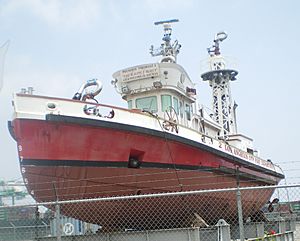Ralph J. Scott (fireboat) facts for kids
 |
|
| History | |
|---|---|
| Name |
|
| Builder | Los Angeles Shipbuilding & Drydock Company |
| Sponsored by | Mrs. Ralph J. Scott |
| Christened | 25 October 1925 |
| Commissioned | 2 December 1925 |
| Out of service | 2003 |
| Status | Awaiting restoration |
| General characteristics as built | |
| Type | Fireboat |
| Tonnage | 152 GT |
| Length | 99.3 ft (30.3 m) |
| Beam | 19 ft (5.8 m) |
| Depth | 9 ft (2.7 m) |
| Installed power |
|
| Propulsion | Triple screw propellers |
| Speed | 17 knots (31 km/h; 20 mph) |
| General characteristics 1945–c.1975 | |
| Installed power |
|
| General characteristics c.1975– | |
| Installed power |
|
|
Ralph J. Scott
|
|
| Location | Berth 85, San Pedro, California |
| Built | 1925 |
| Built by | L.A. Shipbuilding & Drydock Corp. |
| NRHP reference No. | 89001430 |
| Significant dates | |
| Added to NRHP | 30 June 1989 |
| Designated NHL | 30 June 1989 |
The Ralph J. Scott is a famous fireboat that used to work for the Los Angeles Fire Department (LAFD) in the Port of Los Angeles. It was also known as Fireboat #2. This powerful boat helped put out fires in the harbor for 78 years.
The Ralph J. Scott was retired in 2003. A newer fireboat, the Warner L. Lawrence, took its place. Today, the Ralph J. Scott is on display near the Los Angeles Maritime Museum in San Pedro. It was recognized as a National Historic Landmark on June 30, 1989. You can find it at Fire Station 112 in San Pedro, California.
Contents
About the Ralph J. Scott
The Ralph J. Scott is about 100 feet (30 m) long. It could pump an amazing 17,000 US gallons per minute (1.1 m3/s) of water! The boat is named after a former Chief Engineer of the LAFD.
In 1924, people voted to approve money to build a new fireboat. The Los Angeles Shipbuilding and Drydock Corp. in San Pedro won the contract to build it. The boat was finished in 1925. On October 25, 1925, Mrs. Ralph J. Scott officially named the boat Los Angeles City No. 2.
The fireboat started its service on December 2, 1925. It had a crew of 14 people. This included a captain, a pilot, engineers, and firemen.
Boat Design and Power
The Los Angeles City No. 2 was made of riveted steel and painted white. It was 99.3 feet long and 19 feet wide. The boat weighed 152 gross tons and could hold 2,156 gallons of fuel.
When it was first built, the boat had seven 350-horsepower gasoline engines. Three of these engines powered the propellers, making it very fast. It could reach a top speed of 17 knots (31 km/h; 20 mph). The other four engines powered the pumps. This design allowed the boat to pump a lot of water. It had six large pumps that could each pump 1,700 US gallons per minute (0.11 m3/s). This meant a total of 10,200 US gallons per minute (0.64 m3/s)!
In 1945, the original engines were replaced with Hall Scott engines. Later, starting in 1975, the gasoline engines were replaced with more modern diesel engines.
Firefighting Equipment
The Ralph J. Scott had five powerful water cannons, called monitor guns. One of these was a tower gun that could reach 44 feet (13 m) above the water. This was one of the first fireboats to use gasoline engines. It had a special safety system to keep gasoline fumes from building up.
The boat carried many tools for firefighters. This included breathing equipment, tools to force open doors, and powerful hoses. It had 24 hose outlets and 5 large deck guns. One gun, called "Big Bertha," could deliver 10,200 US gallons per minute (0.64 m3/s) of water. The tower turret could rise to 42 feet (13 m) above the water.
Major Fires Fought
The Ralph J. Scott helped fight many important fires in the Port of Los Angeles.
- March 3, 1926: The boat fought its first big fire. This was when the lumber ship Sierra caught fire at a wharf in San Pedro. Many fire companies and other fireboats helped put out this difficult fire. The fire caused over $1,500,000 in damage.
- July 1947: The Los Angeles City No. 2 helped stop a fire at the American President Lines pier and warehouse. It also helped with a burning oil tanker called the SS Markay.
- June 29, 1954: The fireboat helped cool down tanks during a large fire at an oil company. Explosions and fires quickly spread to 11 storage tanks.
- February 24, 1967: The Ralph J. Scott took part in a training exercise called "Operation West Basin." It practiced fighting fires at a dock.
- June 20, 1970: The boat helped fight a fire on the cargo ship SS Pontos in the harbor.
- December 1976: It responded to the explosion of the huge oil tanker Sansinena.
The Fireboat's Station
The Ralph J. Scott's original boathouse was a well-known building on the waterfront. It was called Fire Station 112. This building was taken down in 1986 to make way for a new cargo area.
A new, modern Fire Station #112 was built. It was designed to house the Ralph J. Scott and allow visitors to see it. As of 2012, the boat is waiting to be restored. The Port of Los Angeles plans to build a new place for the restored vessel.
Fire Station 112 has exhibits about the history of LA fireboats. You can learn about the Ralph J. Scott and how this special boat was built and used.

